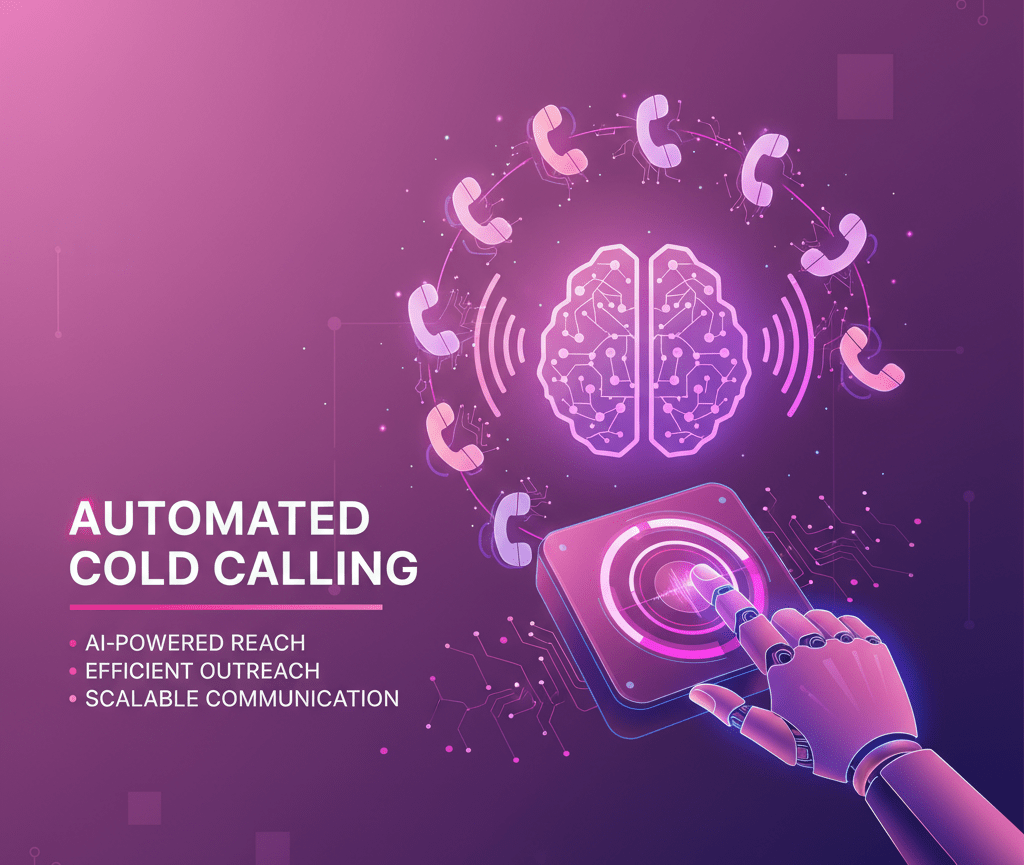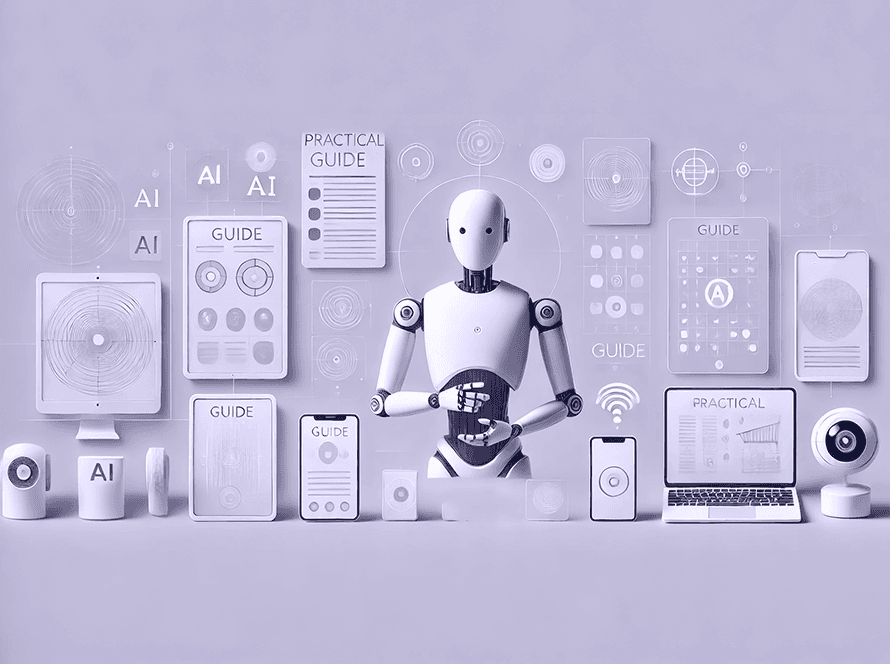“Boost your pipeline with Automated Cold Calling Services that use AI for natural conversation, deep lead qualification, and 24/7 meeting booking.”
Cold calling. The very phrase can send shivers down a salesperson’s spine. It evokes images of endless rejections, monotonous voicemails, and the constant battle against dwindling motivation. For decades, businesses have grappled with the inefficiency of traditional cold outreach. Then came “automated cold calling services,” promising a revolution. But what exactly are they? And more importantly, are they a worthwhile investment for today’s sales teams?
This isn’t about the annoying robocalls that interrupt dinner. We’re moving past those simplistic, legacy auto-dialers. This article will dissect the true potential of modern automated cold calling, especially those powered by conversational AI. We’ll weigh the benefits against the drawbacks, provide a clear framework for calculating ROI, and ultimately, show you how a knowledgeable AI sales agent, like SalesCloser.ai, isn’t just an alternative but a superior evolution that can supercharge your sales pipeline.
The Evolution of Automated Outreach: From Dumb Dialers to Smart Conversational AI
Let’s clear the air first. When most people hear “automated cold calling,” they think of a pre-recorded message blasting to thousands of numbers. This is the realm of the old-school auto-dialer or voice broadcasting alternative. These tools certainly offered scalability. They could dial more numbers faster than any human. However, their limitations were glaring.
- One-Way Communication: They were essentially digital megaphones. No real conversation. No understanding of nuance.
- Irritation Factor: Call recipients quickly grew frustrated. These calls often felt impersonal and intrusive.
- Compliance Nightmares: Navigating TCPA compliant dialing with these systems was a constant headache. Opt-outs were often disregarded, resulting in fines and reputational harm.
- Zero Qualification: They couldn’t qualify a lead beyond a simple button press. A human still had to sift through the “interested” responses.
These legacy systems earned automated cold calling a bad name. They contributed to the negative stereotype. They offered speed, but at a significant cost to brand reputation and actual sales effectiveness.
Enter AI-Powered Cold Calling: A New Frontier
The landscape has changed dramatically. AI-powered cold calling platforms are a distinct entity altogether. We’re talking about sophisticated conversational AI platforms. These aren’t just playing pre-recorded messages. They are engaging in natural, two-way conversations.
Imagine an AI agent that can:
- Understand Context: It processes natural language and understands the intent behind a prospect’s words.
- Answer Questions: It can respond to objections, provide information, and guide the conversation.
- Adapt and Learn: With machine learning, it gets better with every interaction. It refines its approach.
- Qualify Leads: It asks relevant questions, identifies pain points, and determines if a prospect is a good fit.
- Book Meetings: The ultimate goal. It can seamlessly schedule appointments directly into your sales team’s calendar.
This is modern prospecting as a service. It’s a significant leap forward. It addresses many of the core flaws of its predecessors. This is modern outbound calling automation at its best.
Why Consider Automated Sales Outreach with AI?
The appeal of AI telemarketing is strong. Sales leaders face constant pressure to improve cold call success rates and scale their efforts without ballooning their budget. Here’s why businesses are turning to AI:
1. Unmatched Scalability and Efficiency
Human sales development representatives (SDRs) are essential. They bring empathy and critical thinking. But they have limits. They can only make a limited number of calls per day. They get fatigued. Their performance can fluctuate.
AI agents don’t have these limitations.
- 24/7 Operation: An AI can work around the clock, contacting prospects in different time zones without complaint.
- Volume: It can handle hundreds, even thousands, of calls simultaneously. This is a game-changer for businesses with large target lists.
- Consistent Performance: AI doesn’t have bad days. It delivers a consistent message every time, ensuring brand message integrity.
- Reduced Administrative Burden: AI can automatically log calls, update CRM records, and track interactions, streamlining processes and freeing up human SDRs for higher-value tasks.
This level of scalable outbound sales simply isn’t achievable with a human-only team.
2. Cost-Effectiveness: AI vs. Human SDR
This is where the rubber meets the road. Is an AI agent truly more cost-effective than a human SDR? Let’s break it down.
Human SDR Costs:
- Salary: A significant annual expense, varying by location and experience.
- Benefits: Health insurance, retirement plans, paid time off, etc.
- Training: Onboarding, ongoing sales training, and product knowledge. This is a continuous investment.
- Tools: CRM licenses, sales engagement platforms, dialing software.
- Overhead: Office space, equipment, management time.
- Attrition: High turnover rates in SDR roles mean constant recruitment and retraining costs.
When you add all these up, a single human SDR represents a substantial financial commitment.
AI Agent Costs:
- Subscription Fee: Typically a monthly or annual fee based on usage or features.
- Setup/Integration: Initial costs for setting up the AI and integrating with your CRM.
Comparing these two, the operational costs of an AI agent are often dramatically lower over time. An AI doesn’t need benefits, a salary, or an office. Its “training” is usually included in the service, or it learns autonomously.
The ROI Calculation Framework:
To truly understand the worth, you need a clear ROI. Here’s a simplified framework:
- Current State Analysis:
- What is your current cost per qualified lead from cold calling? (Total SDR costs / Number of qualified leads).
- What is your current cost per booked meeting? (Total SDR costs / Number of booked meetings).
- What is the average time a human SDR spends per call, per qualification, per meeting booked?
- What is the average conversion rate from cold call to qualified lead, and qualified lead to booked meeting?
- Projected AI State:
- Estimate the number of calls the AI can make in a given period.
- Project the AI’s qualification rate and meeting booking rate (often provided by the service provider or through a pilot program).
- Calculate the total cost of the AI service.
- Compare and Contrast:
- Calculate the new cost per qualified lead and book a meeting with the AI.
- Factor in the increased volume and speed of outreach.
- Consider the time saved for human SDRs, allowing them to focus on closing deals.
Example:
Let’s say a human SDR costs $70,000/year (salary, benefits, and overhead) and books 10 meetings per month, each costing $700.
An AI agent costing $2,000/month ($24,000/year) might book 30 meetings per month. That’s $66 per meeting. The difference is stark. And this doesn’t even account for the sheer volume of leads the AI can qualify that a human simply can’t reach.
3. Data-Driven Insights and Optimization
Modern prospecting methods thrive on data. AI cold calling platforms generate a wealth of information.
- Call Analytics: Detailed reports on call duration, sentiment analysis, common objections, and successful conversation paths.
- Performance Metrics: Track conversion rates at every stage of the funnel.
- A/B Testing: Easily test different scripts, opening lines, and value propositions to see what resonates best with prospects.
This data allows sales managers to refine their strategy continually. They can optimize scripts, identify training gaps for human SDRs (by learning from the AI’s successful interactions), and make more informed decisions about their outreach efforts. It’s like having a dedicated sales scientist constantly working to improve your process.
4. Human SDRs Focus on What They Do Best
This is one of the most compelling arguments. The perception that AI replaces human jobs is often misguided. Instead, AI augments human capabilities. By offloading the repetitive, often soul-crushing task of initial cold outreach, AI frees up human SDRs and account executives to focus on more strategic tasks.
They can then focus on:
- In-depth Qualification: Diving deeper with highly qualified leads delivered by the AI.
- Building Rapport: Nurturing relationships with prospects who are genuinely interested.
- Complex Problem Solving: Addressing intricate customer needs and tailoring solutions.
- Closing Deals: This is where human empathy, negotiation skills, and strategic thinking are irreplaceable.
Ultimately, AI allows your sales team to work smarter, not just harder.
Potential Pitfalls and How to Mitigate Them
No technology is a silver bullet. While AI-powered cold calling services offer immense potential, it’s crucial to acknowledge and address potential downsides.
1. Brand Reputation and Customer Experience
This is the biggest concern, stemming from the legacy of robocalling. If an AI sounds too robotic, if it can’t handle unexpected responses, or if it constantly tries to push a sale, it can damage your brand. Prospects may hang up, block your number, and associate your company with annoying calls.
Mitigation:
- Invest in High-Quality AI: Not all conversational AIs are created equal. Prioritize platforms that boast natural language processing (NLP) capabilities, realistic voice synthesis, and the ability to maintain fluid, human-like conversations. This is where providers like SalesCloser.ai differentiate themselves.
- Thorough Scripting and Training: Develop comprehensive scripts that anticipate common questions and objections. Continuously train the AI with new data and feedback to improve its conversational flow.
- Human Oversight: Even with advanced AI, human oversight is essential. Monitor calls, review transcripts, and intervene if necessary. Use the AI to qualify, but let humans handle complex or sensitive interactions.
- Opt-Out Mechanisms: Ensure easy opt-out options are available. Respect prospect preferences immediately.
2. TCPA and Other Compliance Issues
Regulatory compliance, particularly with the Telephone Consumer Protection Act (TCPA) in the US, is non-negotiable. Non-compliance can result in substantial fines and legal disputes.
Mitigation:
- Partner with Compliant Providers: Choose an automated cold calling service that explicitly states its commitment to TCPA compliance and has built-in features to help you adhere to regulations (e.g., DNC list scrubbing, call time restrictions, consent tracking).
- Understand the Nuances: The TCPA is a complex law. Consult legal counsel to ensure your specific use case and scripting are compliant.
- Consent is Key: Always prioritize obtaining proper consent, especially for SMS or prerecorded voice calls. For live calls, even AI-driven ones, adhering to DNC lists and respecting opt-out requests is paramount.
3. Integration Challenges
Integrating a new system into your existing tech stack (CRM, marketing automation, etc.) can sometimes be a hurdle. Data silos and inefficient workflows can negate some of the efficiency gains that can be achieved.
Mitigation:
- API Capabilities: Ensure the AI platform offers robust API integrations with your key business systems.
- CRM Compatibility: Verify seamless integration with your CRM (e.g., Salesforce, HubSpot, Zoho) for automatic lead updates and meeting scheduling.
- Staged Rollout: Begin with a pilot program or a more minor team to identify and resolve integration issues before deploying on a full scale.
4. The “Human Touch” Limitation
While AI has made significant progress, it still cannot yet exhibit genuine empathy, intuition, or establish deep, personal rapport in the same way that humans can, for highly complex sales or those requiring intricate negotiation, a human touch remains essential.
Mitigation:
- Define AI’s Role: Utilize AI for what it does best —high-volume, initial qualification, and meeting booking. Let human sales professionals take over once a lead is genuinely engaged and qualified.
- Warm Hand-offs: Ensure a smooth transition from the AI to a human. The AI should provide all relevant conversation history to the human so that they can pick up seamlessly.
- Hybrid Approach: The most effective strategy often involves a blend of AI and human effort, leveraging the strengths of both.
Measuring Success: KPIs for Your Automated Cold Calling Campaign
To determine if automated cold calling services are worth it, you need to track the right metrics.
- Call Volume: How many calls is the AI making per day/week/month?
- Connect Rate: Percentage of calls where the AI successfully connects with a live person.
- Conversation Rate: Percentage of connected calls where the AI engages in a meaningful, two-way conversation.
- Qualification Rate: Percentage of conversations that result in a qualified lead.
- Meeting Booked Rate: Percentage of qualified leads that result in a booked meeting.
- Cost Per Qualified Lead (CPQL): Total cost of the AI service divided by the number of qualified leads generated.
- Cost Per Booked Meeting (CPBM): Total cost of the AI service divided by the number of booked meetings.
- Sales Cycle Length Reduction: Is the AI helping to shorten the time from initial contact to closed deal?
- Human SDR Productivity: Are your human SDRs booking more follow-up meetings or closing more deals because of the AI’s efforts?
- Brand Sentiment: Monitor feedback channels for any negative comments related to automated calls.
By consistently tracking these KPIs, you can accurately assess the performance of your automated sales outreach and demonstrate its tangible value.

Introducing SalesCloser.ai: The Next Evolution, Not Just an Automation Tool
As we’ve explored, the world of automated cold calling services is nuanced. It’s not a simple yes-or-no answer. The key lies in the type of automation you choose. This brings us to SalesCloser.ai, a platform that transcends the limitations of traditional automated services.
SalesCloser.ai isn’t just an auto-dialer. It’s an intelligent AI sales agent. It’s engineered to overcome the old system’s flaws by engaging in natural, two-way conversations. This isn’t about blasting pre-recorded messages. This is about genuine interaction.
Here’s how SalesCloser.ai positions itself as a definitively valuable investment:
- Truly Conversational AI: At its core, SalesCloser.ai is built on advanced natural language processing. It understands context, handles objections dynamically, and maintains a fluid, human-like dialogue. Prospects often don’t even realize they’re speaking with an AI.
- Deep Lead Qualification: SalesCloser.ai goes beyond basic interest. It’s designed to ask intelligent, probing questions to qualify leads truly. It uncovers pain points, identifies budget and authority, and determines urgency. This means your human sales team receives genuinely warm leads.
- Seamless Meeting Booking: The AI agent can access your team’s calendars in real-time. It handles the entire meeting scheduling process, sending invites, and confirming details. This eliminates the back-and-forth typically required for booking.
- Brand-Safe Interactions: SalesCloser.ai prioritizes a positive prospect experience. Its natural language capabilities and adaptive scripting ensure conversations are helpful, not intrusive, protecting your brand reputation.
- Full Compliance: Built-in features and best practices ensure TCPA compliance and adherence to other relevant regulations, giving you peace of mind.
- Scalability without Compromise: You get the immense scalability of an automated system. However, you don’t sacrifice the quality of interaction. You scale intelligent conversations, not just call volume.
- Actionable Insights: Every interaction provides valuable data. SalesCloser.ai offers detailed analytics, enabling you to refine your messaging, understand your prospects’ needs, and continually improve your outbound sales strategy.
SalesCloser.ai serves as your always-on, indefatigable SDR. It handles initial outreach, objection handling, and qualification. It then delivers perfectly primed leads directly to your human sales team, ready for deeper engagement and closing. This makes it a tool that truly supercharges the sales pipeline. It transforms cold outreach from a chore into a highly efficient, intelligent, and scalable lead generation engine.
Conclusion: A Definitive Yes for Modern AI Sales Agents
Are automated cold calling services worth it? The answer is a resounding YES, but with a critical caveat. Not all automated services are created equal. Legacy auto-dialers? Their value is debatable and often outweighed by their drawbacks. However, sophisticated, conversational AI platforms like SalesCloser.ai represent a paradigm shift.
They are a worthwhile, even essential, investment for modern sales teams seeking to enhance cold call success rates, achieve scalable outbound sales, and refine their prospecting methods. By leveraging AI-powered cold calling, businesses can significantly reduce costs, increase efficiency, generate higher-quality leads, and empower their human sales force to focus on what they do best: building relationships and closing deals.
The future of sales outreach isn’t about replacing human; it’s about enhancing their capabilities. It’s about augmenting them with intelligent AI. It’s about moving beyond the tedious to the strategic. SalesCloser.ai proves that the right AI sales agent isn’t just an expense; it’s a powerful asset that drives tangible ROI and provides a significant competitive advantage. It’s time to embrace the evolution and unlock the full potential of your sales pipeline.
FAQs About Automated Cold Calling Services
Q1: What is the main difference between old auto-dialers and modern AI-powered cold calling services?
A1: Old auto-dialers primarily broadcast pre-recorded messages. They offer one-way communication and lack intelligence. Modern AI-powered services use sophisticated conversational AI. They engage in natural, two-way dialogues. They understand context, answer questions, and adapt their responses.
Q2: How do AI-powered cold calling services ensure TCPA compliance?
A2: Reputable AI cold calling services build compliance features into their platforms. This includes DNC list scrubbing, adherence to calling hour restrictions, and mechanisms for prospects to opt out of receiving calls. They help businesses stay compliant. It remains crucial for companies to understand and comply with all relevant regulations.
Q3: Can an AI sales agent truly qualify leads as well as a human SDR?
A3: An AI sales agent excels at initial, high-volume qualification. It asks targeted questions. It identifies basic fit, pain points, and interest levels. It can uncover specific needs. For the more complex and nuanced qualification that requires human empathy, a human SDR will take over. The AI prepares the lead.
Q4: Will using an AI for cold calling damage my brand’s reputation?
A4: This risk exists with poorly implemented or robotic-sounding AI. However, high-quality conversational AI platforms are designed to sound natural. They aim for helpful interactions. Platforms like SalesCloser.ai prioritize a positive prospect experience. This protects your brand reputation.
Q5: How does an AI sales agent book meetings directly into my sales team’s calendar?
A5: AI sales agents integrate with your existing calendar systems. For example, they can connect to Google Calendar or Outlook Calendar. The AI checks availability in real-time. It then proposes suitable meeting slots to the prospect. Once confirmed, it automatically books the meeting. It sends invites to all parties.
Q6: What kind of ROI can I expect from investing in an automated cold calling service?
A6: ROI varies. It depends on factors like your industry, target market, and the specific AI platform. Expect significant savings on operational costs compared to human SDRs. Also, expect higher lead volume and increased meeting booking rates. A clear ROI calculation framework considers cost per qualified lead and cost per booked meeting. It compares current methods against AI performance.
Q7: Is AI-powered cold calling only for large enterprises?
A7: Not at all. While enterprises benefit from the scalability, even small and medium-sized businesses can leverage AI. They can improve cold call success rates and expand their outreach. It allows them to compete more effectively. It democratizes access to powerful prospecting tools.
Q8: What kind of training does an AI sales agent require?
A8: The AI platform itself often comes pre-trained on vast datasets. However, you will “train” it by providing your specific scripts, product information, and target audience details. You refine its responses over time. This occurs through ongoing feedback and analysis of interaction.
Q9: How do I get my human sales team to adopt and work with an AI sales agent?
A9: Clear communication is key. Position the AI as a tool to support them, not replace them. Emphasize how it removes monotonous tasks. It delivers warmer leads. This lets them focus on closing. Provide training on how to leverage the AI’s output effectively. Showcase the positive impact on their quota.
Q10: Can an AI handle objections during a cold call?
A10: Yes, sophisticated AI sales agents are designed to handle common objections. They understand the intent behind objections. They can provide relevant counter-arguments or information. They can guide the conversation forward. They use pre-programmed responses and learn from past interactions.








